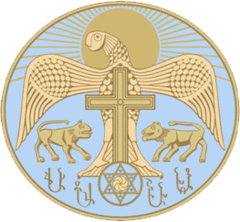House of Hasan-Jalalyan
| Hasan-Jalalyan Հասան-Ջալալյաններ |
|
|---|---|
 
|
|
| Country | Artsakh |
| Parent house |
Aranshahik Bagratuni Dynasty Artsruni Arsacid Dynasty |
| Titles | |
| Founded | 1214 |
| Founder | Hasan-Jalal Dawla |
| Final ruler | Allahverdi II Hasan-Jalalyan |
| Ethnicity | Armenian |
The House of Hasan-Jalalyan (Armenian: Հասան-Ջալալյաններ) was an Armenian dynasty that ruled the region of Khachen (Greater Artsakh) from 1214 onwards in what are now the regions of lower Karabakh, Nagorno-Karabakh and small part of Syunik. It was named after Hasan-Jalal Dawla (Հասան-Ջալալ Դոլա), an Armenian feudal prince from Khachen. The Hasan-Jalalyan family was able to maintain its autonomy throughout several centuries of foreign domination of the region by Seljuk Turks, Persians and Mongols as they, as well as the other Armenian princes and meliks of Khachen, saw themselves of holding the last bastion of Armenian independence in the region.
Through their many patronages of churches and other monuments, the Hasan-Jalalyans helped cultivate Armenian culture throughout the region. By the late 16th century, the Hasan-Jalalyan family had branched out to establish melikdoms in Gulistan and Jraberd, making them, along with Khachen, Varanda and Dizak, a part of what was then known as the "Melikdoms of Khamsa."
Hasan-Jalal traced his descent to the Armenian Aranshahik dynasty, a family that predated the establishment of the Parthian Arsacids in the region. Hasan-Jalal's ancestry was "almost exclusively" Armenian according to historian Robert H. Hewsen, a professor at Rowan University and an expert on the history of the Caucasus:
...
Wikipedia
